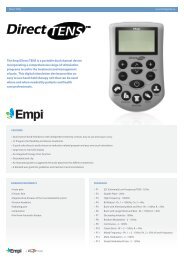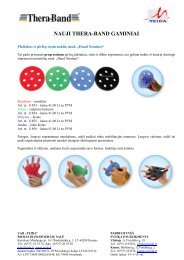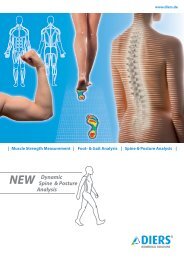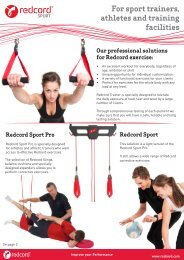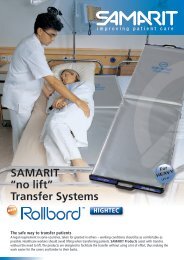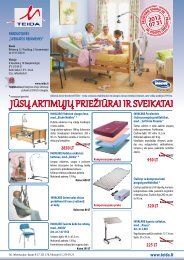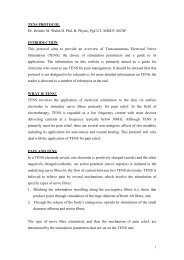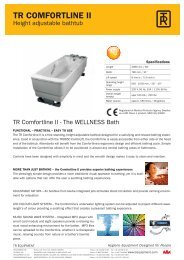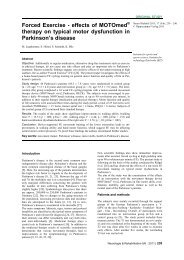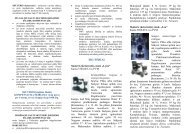Physiotherapy in the Intensive Care Unit - Teida
Physiotherapy in the Intensive Care Unit - Teida
Physiotherapy in the Intensive Care Unit - Teida
Create successful ePaper yourself
Turn your PDF publications into a flip-book with our unique Google optimized e-Paper software.
Ne<strong>the</strong>rlands Journal of Critical <strong>Care</strong><br />
Copyright © 2011, Nederlandse Verenig<strong>in</strong>g voor <strong>Intensive</strong> <strong>Care</strong>. All Rights Reserved. Received January 2010; accepted August 2010<br />
REVIEW<br />
<strong>Physio<strong>the</strong>rapy</strong><strong>in</strong><strong>the</strong><strong>Intensive</strong><strong>Care</strong><strong>Unit</strong><br />
RGossel<strong>in</strong>k,BClerckx,CRobbeets,TVanhullebusch,GVanpee,JSegers<br />
FacultyofK<strong>in</strong>esiologyandRehabilitationSciences,KatholiekeUniversiteitLeuven,Belgium<br />
DivisionofRespiratoryRehabilitation,UniversityHospitalGasthuisbergLeuven,Belgium<br />
Abstract - Physio<strong>the</strong>rapists are <strong>in</strong>volved <strong>in</strong> <strong>the</strong> management of patients with critical illness. <strong>Physio<strong>the</strong>rapy</strong> assessment is focused<br />
on physical decondition<strong>in</strong>g and related problems (muscle weakness, jo<strong>in</strong>t stiffness, impaired functional exercise capacity, physical<br />
<strong>in</strong>activity) and respiratory conditions (reta<strong>in</strong>ed airway secretions, atelectasis and respiratory muscle weakness) to identify targets for<br />
physio<strong>the</strong>rapy. Evidence-based targets for physio<strong>the</strong>rapy are decondition<strong>in</strong>g, impaired airway clearance, atelectasis, (re-)<strong>in</strong>tubation<br />
avoidance and wean<strong>in</strong>g failure. Early physical activity and mobilisation are essential <strong>in</strong> <strong>the</strong> prevention, attenuation or reversion of physical<br />
decondition<strong>in</strong>g related to critical illness. A variety of modalities for exercise tra<strong>in</strong><strong>in</strong>g and early mobility are evidence-based and must be<br />
implemented depend<strong>in</strong>g on <strong>the</strong> stage of critical illness, co-morbid conditions and cooperation of <strong>the</strong> patient. The physio<strong>the</strong>rapist should<br />
be responsible for implement<strong>in</strong>g mobilization plans and exercise prescription and make recommendations for progression of <strong>the</strong>se<br />
plans, jo<strong>in</strong>tly with medical and nurs<strong>in</strong>g staff.<br />
Keywords- physio<strong>the</strong>rapy, muscle weakness, decondition<strong>in</strong>g, pulmonary complications, mobilisation, wean<strong>in</strong>g failure, atelectasis<br />
Introduction<br />
The progress of <strong>in</strong>tensive care medic<strong>in</strong>e has dramatically improved<br />
survival of critically ill patients, especially <strong>in</strong> patients with acute<br />
respiratory distress syndrome (ARDS) [1]. This improved survival<br />
is, however, oftentimes associated with general decondition<strong>in</strong>g,<br />
muscle weakness, dyspnea, depression, anxiety and reduced<br />
health-related quality of life after <strong>in</strong>tensive care unit (ICU)<br />
discharge [2]. Decondition<strong>in</strong>g and specifically muscle weakness<br />
are suggested to have an important role <strong>in</strong> <strong>the</strong> impaired long-term<br />
functional status <strong>in</strong> survivors of critical illness [3,4].<br />
Bed rest and immobility dur<strong>in</strong>g critical illness may result<br />
<strong>in</strong> profound physical decondition<strong>in</strong>g. These effects can be<br />
exacerbated by <strong>in</strong>flammation, lack of glycemic control and<br />
pharmacological agents [5]. Skeletal muscle weakness <strong>in</strong> <strong>the</strong><br />
<strong>in</strong>tensive care unit is observed <strong>in</strong> 25% of patients ventilated for<br />
more than 7 days [6]. Development of neuropathy or myopathy also<br />
contributes to wean<strong>in</strong>g failure [7]. F<strong>in</strong>ally, muscle weakness has<br />
been l<strong>in</strong>ked with <strong>in</strong>creased mortality [8]. Respiratory dysfunction<br />
is a common problem <strong>in</strong> critically ill patients or accompanies<br />
o<strong>the</strong>r medical conditions necessitat<strong>in</strong>g ICU admission. Failure of<br />
ei<strong>the</strong>r of <strong>the</strong> two primary components of <strong>the</strong> respiratory system<br />
(i.e. <strong>the</strong> gas exchange membrane and <strong>the</strong> ventilatory pump) can<br />
result <strong>in</strong> a need for mechanical ventilation. Impaired global and/<br />
or regional ventilation, decreased lung compliance and <strong>in</strong>creased<br />
airway resistance may contribute to <strong>in</strong>creased work of breath<strong>in</strong>g<br />
and respiratory dysfunction. In addition, respiratory muscle<br />
Correspondence<br />
R Gossel<strong>in</strong>k<br />
E-mail: rik.gossel<strong>in</strong>k@faber.kuleuven.be<br />
66 NETH J CRIT CARE - VOLUME 15 - NO 2 - APRIL 2011<br />
weakness affects <strong>the</strong> ventilatory pump capacity and may also lead<br />
to respiratory dysfunction. Although most patients on mechanical<br />
ventilation are extubated <strong>in</strong> less than 3 days, still approximately<br />
20% require prolonged ventilatory support [9]. Prolonged ventilator<br />
dependence is a major medical problem but it is also an extremely<br />
uncomfortable state for a patient, carry<strong>in</strong>g important psychosocial<br />
implications.<br />
Physio<strong>the</strong>rapists are <strong>in</strong>volved <strong>in</strong> <strong>the</strong> prevention and treatment<br />
of decondition<strong>in</strong>g and <strong>in</strong> <strong>the</strong> treatment of respiratory conditions <strong>in</strong><br />
critically ill patients [10]. Their role varies across units, hospitals,<br />
and countries [11] and is appreciated by medical directors as well<br />
as patients. <strong>Physio<strong>the</strong>rapy</strong> assessment of critically ill patients is<br />
directed to deficiencies at a physiological and functional level and<br />
less by <strong>the</strong> medical diagnosis [12]. Accurate and valid assessment<br />
of respiratory conditions, decondition<strong>in</strong>g and related problems<br />
is of paramount importance for physio<strong>the</strong>rapists. In addition,<br />
physio<strong>the</strong>rapists can contribute to <strong>the</strong> patient’s overall well-be<strong>in</strong>g<br />
by provid<strong>in</strong>g emotional support and enhanc<strong>in</strong>g communication.<br />
Earlymobilizationandphysicalactivity<br />
Reductions <strong>in</strong> functional performance, exercise capacity, and<br />
quality of life <strong>in</strong> ICU survivers <strong>in</strong>dicate <strong>the</strong> need for rehabilitation<br />
follow<strong>in</strong>g ICU stay [3], but also underscore <strong>the</strong> need for assessment<br />
and measures to prevent or attenuate decondition<strong>in</strong>g and loss of<br />
physical function dur<strong>in</strong>g ICU stay. It is important to prevent or<br />
attenuate muscle decondition<strong>in</strong>g as early as possible <strong>in</strong> patients<br />
with an expected prolonged bed rest [13]. Recent scientific and<br />
cl<strong>in</strong>ical <strong>in</strong>terest and evidence have given support for a safe and early<br />
physical activity and mobilization approach towards <strong>the</strong> critically ill<br />
patient by ICU team members [14-18]. Despite <strong>the</strong> evidence, <strong>the</strong><br />
amount of rehabilitation performed <strong>in</strong> ICUs is often <strong>in</strong>adequate and,<br />
as a rule, rehabilitation is better organized <strong>in</strong> wean<strong>in</strong>g centres or<br />
GB 713.4/W142
Ne<strong>the</strong>rlands Journal of Critical <strong>Care</strong><br />
<strong>Physio<strong>the</strong>rapy</strong> <strong>in</strong> <strong>the</strong> <strong>Intensive</strong> <strong>Care</strong> <strong>Unit</strong><br />
respiratory <strong>in</strong>tensive care units [19,20]. The major reason is that<br />
<strong>the</strong> approach <strong>in</strong> rehabilitation is less driven by medical diagnosis,<br />
<strong>in</strong>stead rehabilitation is focus<strong>in</strong>g on deficiencies <strong>in</strong> <strong>the</strong> broader scope<br />
of health problems as def<strong>in</strong>ed <strong>in</strong> <strong>the</strong> International Classification of<br />
Function<strong>in</strong>g, Disability and Health [21]. This classification helps<br />
to identify problems and <strong>the</strong> prescription of <strong>in</strong>terventions at <strong>the</strong><br />
level of impairments of body structure (anatomical parts of <strong>the</strong><br />
body, such as organs, limbs and <strong>the</strong>ir components) and body<br />
function (physiological functions of body systems (<strong>in</strong>clud<strong>in</strong>g<br />
psychological functions) as well as activity limitations (difficulties<br />
an <strong>in</strong>dividual may have <strong>in</strong> perform<strong>in</strong>g activities) and participation<br />
restrictions (problems an <strong>in</strong>dividual may experience <strong>in</strong> <strong>in</strong>volvement<br />
<strong>in</strong> life situations). Therefore, accurate assessment of <strong>the</strong> level of<br />
cooperation, cardiorespiratory reserve, muscle strength (figure 1),<br />
jo<strong>in</strong>t mobility, functional status (Functional Independence Measure,<br />
Berg Balance scale, Functional Ambulation Categories) and quality<br />
of life (e.g. Short Form-36, disease-specific questionnaires) should<br />
precede early mobilization and physical activity.<br />
Physical activity and exercise should be targeted at <strong>the</strong><br />
appropriate <strong>in</strong>tensity and with <strong>the</strong> appropriate exercise modality.<br />
Figure 1. Assessment of muscle strength with a handgrip dynamometer<br />
The risk of mov<strong>in</strong>g a critically ill patient is weighed aga<strong>in</strong>st <strong>the</strong> risk of<br />
immobility and recumbency and when employed requires str<strong>in</strong>gent<br />
monitor<strong>in</strong>g to ensure <strong>the</strong> mobilization is <strong>in</strong>stituted appropriately<br />
and safely. Acutely ill, uncooperative patients will be treated with<br />
modalities such as passive range of motion, muscle stretch<strong>in</strong>g,<br />
spl<strong>in</strong>t<strong>in</strong>g, body position<strong>in</strong>g, passive cycl<strong>in</strong>g with a bed cycle, or<br />
electrical muscle stimulation that will not need cooperation of<br />
<strong>the</strong> patient and will put m<strong>in</strong>imal stress on <strong>the</strong> cardiorespiratory<br />
system. On <strong>the</strong> o<strong>the</strong>r hand, <strong>the</strong> stable cooperative patient, beyond<br />
<strong>the</strong> acute illness phase but still on mechanical ventilation, will be<br />
able to be mobilized on <strong>the</strong> edge of <strong>the</strong> bed, transfer to a chair,<br />
perform resistance muscle tra<strong>in</strong><strong>in</strong>g or active cycl<strong>in</strong>g with a bed<br />
cycle or chair cycle and walk with or without assistance. The<br />
flow diagram ‘Start to move’ was developed <strong>in</strong> our center (figure<br />
2), <strong>in</strong>spired upon <strong>the</strong> flow diagram by Morris et al. [15], and is an<br />
example of a multidiscipl<strong>in</strong>ary step-up approach. Six levels are<br />
identified and each level def<strong>in</strong>es <strong>the</strong> modality of body position<strong>in</strong>g<br />
(mobilization) and physio<strong>the</strong>rapy which are based on assessment<br />
of medical condition (cardiorespiratory and neurological status,<br />
level of cooperation and functional status (muscle strength, level of<br />
mobility). Each day <strong>the</strong> ICU team def<strong>in</strong>es <strong>the</strong> ‘start to move’ level <strong>in</strong><br />
every patient, especially <strong>in</strong> those fac<strong>in</strong>g an extended ICU stay.<br />
The uncooperative critically ill patient<br />
The importance of body position<strong>in</strong>g (“stirr<strong>in</strong>g up” patients)<br />
was reported as early as <strong>the</strong> 1940s [22]. To simulate <strong>the</strong> normal<br />
perturbations that <strong>the</strong> human body experiences <strong>in</strong> health, <strong>the</strong><br />
patient who is critically ill needs to be positioned upright (well<br />
supported), and rotated when recumbent. These perturbations<br />
need to be scheduled frequently to avoid <strong>the</strong> adverse effects of<br />
prolonged static position<strong>in</strong>g on respiratory, cardiac, and circulatory<br />
function. O<strong>the</strong>r <strong>in</strong>dications for position<strong>in</strong>g <strong>in</strong>clude <strong>the</strong> management<br />
of soft tissue contracture, protection of flaccid limbs and lax jo<strong>in</strong>ts,<br />
nerve imp<strong>in</strong>gement, and sk<strong>in</strong> breakdown. The efficacy of twohourly<br />
patient rotation which is common <strong>in</strong> cl<strong>in</strong>ical practice has<br />
not been verified scientifically. Bed design features <strong>in</strong> critical care<br />
should <strong>in</strong>clude hip and knee breaks so <strong>the</strong> patient can approximate<br />
upright sitt<strong>in</strong>g as much as can be tolerated. Heavy care patients<br />
such as those who are sedated, or have overweight may need<br />
chairs with greater support such as stretcher chairs. Lifts may be<br />
needed to change a patient’s position safely. In sedated patients<br />
o<strong>the</strong>r treatment modalities than body position<strong>in</strong>g are often not<br />
considered. Rehabilitation was considered as contra<strong>in</strong>dicated,<br />
ma<strong>in</strong>ly due to sedation and renal replacement, <strong>in</strong> more than 40% of<br />
<strong>the</strong> ICU days of critically ill patients [23]. However, o<strong>the</strong>r treatment<br />
modalities, such as passive cycl<strong>in</strong>g, jo<strong>in</strong>t mobility, muscle stretch<strong>in</strong>g<br />
and neuromuscular electrical stimulation, may not <strong>in</strong>terfere with<br />
sedation of <strong>the</strong> patient or renal replacement <strong>the</strong>rapy.<br />
Passive stretch<strong>in</strong>g or range of motion exercise may have a<br />
particularly important role <strong>in</strong> <strong>the</strong> management of patients who are<br />
unable to move spontaneously. Studies <strong>in</strong> healthy subjects have<br />
shown that passive stretch<strong>in</strong>g decreases stiffness and <strong>in</strong>creases<br />
extensibility of <strong>the</strong> muscle [24,25]. Cont<strong>in</strong>uous passive motion<br />
(CPM) prevents contractures and has been assessed <strong>in</strong> patients<br />
with critical illness subjected to prolonged <strong>in</strong>activity [26]. In critically<br />
NETH J CRIT CARE - VOLUME 15 - NO 2 - APRIL 2011 67
Ne<strong>the</strong>rlands Journal of Critical <strong>Care</strong><br />
R Gossel<strong>in</strong>k, B Clerckx, C Robbeets, T Vanhullebusch, G Vanpee, J Segers<br />
ill patients, 3 times 3 hours of CPM per day reduced fiber atrophy<br />
and prote<strong>in</strong> loss, compared with passive stretch<strong>in</strong>g for 5 m<strong>in</strong>utes,<br />
twice daily [26]. For patients who cannot be actively mobilized and<br />
have high risk of soft tissue contracture, such as follow<strong>in</strong>g severe<br />
burns, trauma, and some neurological conditions, spl<strong>in</strong>t<strong>in</strong>g may be<br />
<strong>in</strong>dicated.<br />
The application of exercise tra<strong>in</strong><strong>in</strong>g <strong>in</strong> <strong>the</strong> early phase of ICU<br />
admission is often more complicated due to lack of cooperation<br />
and <strong>the</strong> cl<strong>in</strong>ical status of <strong>the</strong> patient. Recent technological<br />
development resulted <strong>in</strong> a bedside cycle ergometer for (active<br />
or passive) leg cycl<strong>in</strong>g dur<strong>in</strong>g bed rest (figure 3a). The bedside<br />
cycle ergometer (figure 3b) may allow prolonged cont<strong>in</strong>uous<br />
mobilization with rigorous control of exercise <strong>in</strong>tensity and duration.<br />
Fur<strong>the</strong>rmore, <strong>the</strong> tra<strong>in</strong><strong>in</strong>g <strong>in</strong>tensity can be cont<strong>in</strong>uously adjusted<br />
Figure 2. ‘Start to move’ – protocol Leuven: step-up approach for progressive mobilisation and physical activity program.<br />
LEVEL 0 LEVEL 1 LEVEL 2 LEVEL 3 LEVEL 4 LEVEL 5<br />
NO<br />
COOPERATION<br />
NO-LOW<br />
COOPERATION<br />
MODERATE<br />
COOPERATION<br />
CLOSE TO FULL<br />
COOPERATION<br />
FULL<br />
COOPERATION<br />
FULL<br />
COOPERATION<br />
S5Q 1 = 0<br />
S5Q 1 < 3<br />
S5Q 1 ≥ 3<br />
S5Q 1 ≥ 4/5<br />
S5Q 1 = 5<br />
S5Q 1 = 5<br />
FAILS BASIC<br />
ASSESSMENT 2<br />
PASSES BASIC<br />
ASSESSMENT 3 +<br />
PASSES BASIC<br />
ASSESSMENT 3 +<br />
PASSES BASIC<br />
ASSESSMENT 3 +<br />
PASSES BASIC<br />
ASSESSMENT 3 +<br />
PASSES BASIC<br />
ASSESSMENT 3 +<br />
BASIC<br />
ASSESSMENT =<br />
-Cardiorespiratory<br />
unstable:<br />
MAP < 60mmHg or<br />
FiO 2 > 60% or<br />
PaO 2 /FiO 2 < 200 or<br />
RR > 30 bpm<br />
-Neurologically<br />
unstable<br />
-Acute surgery<br />
-Temp > 40°C<br />
BODY<br />
POSITIONING 4<br />
2hr turn<strong>in</strong>g<br />
PHYSIOTHERAPY:<br />
No treatment<br />
Neurological or<br />
surgical or trauma<br />
condition does not<br />
allow transfer to<br />
chair<br />
BODY<br />
POSITIONING 4<br />
2hr turn<strong>in</strong>g<br />
Fowler’s position<br />
Spl<strong>in</strong>t<strong>in</strong>g<br />
PHYSIOTHERAPY 4<br />
Passive range of<br />
motion<br />
Passive bed cycl<strong>in</strong>g<br />
NMES<br />
Obesity or neurological<br />
or surgical or trauma<br />
condition does not allow<br />
active transfer to chair<br />
(even if MRCsum ≥ 36)<br />
BODY POSITIONING 4<br />
2hr turn<strong>in</strong>g<br />
Spl<strong>in</strong>t<strong>in</strong>g<br />
Upright sitt<strong>in</strong>g position <strong>in</strong><br />
bed<br />
Passive transfer bed to<br />
chair<br />
PHYSIOTHERAPY 4<br />
Passive/Active range of<br />
motion<br />
Resistance tra<strong>in</strong><strong>in</strong>g arms<br />
and legs<br />
Passive/Active leg<br />
and/or cycl<strong>in</strong>g <strong>in</strong> bed or<br />
chair<br />
NMES<br />
MRCsum ≥ 36 +<br />
BBS Sit to stand = 0 +<br />
BBS Stand<strong>in</strong>g = 0 +<br />
BBS Sitt<strong>in</strong>g ≥ 1<br />
BODY POSITIONING 4<br />
2hr turn<strong>in</strong>g<br />
Passive transfer bed to<br />
chair<br />
Sitt<strong>in</strong>g out of bed<br />
Stand<strong>in</strong>g with assist (2 ≥<br />
pers)<br />
PHYSIOTHERAPY 4<br />
Passive/Active range of<br />
motion<br />
Resistance tra<strong>in</strong><strong>in</strong>g arms<br />
and legs<br />
Active leg and/or arm<br />
cycl<strong>in</strong>g <strong>in</strong> bed or chair<br />
NMES<br />
ADL<br />
MRCsum ≥ 48 +<br />
BBS Sit to stand ≥ 0 +<br />
BBS Stand<strong>in</strong>g ≥ 0 +<br />
BBS Sitt<strong>in</strong>g ≥ 2<br />
BODY POSITIONING 4<br />
Active transfer bed to<br />
chair<br />
Sitt<strong>in</strong>g out of bed<br />
Stand<strong>in</strong>g with assist<br />
(≥1 pers)<br />
PHYSIOTHERAPY 4<br />
Passive/Active range<br />
of motion<br />
Resistance tra<strong>in</strong><strong>in</strong>g<br />
arms and legs<br />
Active leg and/or arm<br />
cycl<strong>in</strong>g <strong>in</strong> chair or bed<br />
Walk<strong>in</strong>g (with<br />
assistance/frame)<br />
NMES<br />
ADL<br />
MRCsum ≥ 48 +<br />
BBS Sit to stand ≥ 1 +<br />
BBS Stand<strong>in</strong>g ≥ 2 +<br />
BBS Sitt<strong>in</strong>g ≥ 3<br />
BODY POSITIONING 4<br />
Active transfer bed to<br />
chair<br />
Sitt<strong>in</strong>g out of bed<br />
Stand<strong>in</strong>g<br />
PHYSIOTHERAPY 4<br />
Passive/Active range<br />
of motion<br />
Resistance tra<strong>in</strong><strong>in</strong>g<br />
arms and legs<br />
Active leg and arm<br />
cycl<strong>in</strong>g <strong>in</strong> chair<br />
Walk<strong>in</strong>g (with<br />
assistance)<br />
NMES<br />
ADL<br />
‘Start to move’ - protocol Leuven: step-up approach of progressive mobilisation<br />
and physical activity program<br />
1S5Q: response to 5 standardized questions for cooperation:<br />
Open and close your eyes<br />
Look at me<br />
Open your mouth and stick out your tongue<br />
Shake yes and no (nod your head)<br />
I will count to 5, frown your eyebrows afterwards<br />
2 : FAILS = at least 1 risk factor present<br />
3 : if basic assessment failed, decrease to level 0<br />
4 : safety: each activity should be deferred if severe adverse events (cv.,<br />
resp. and subject. <strong>in</strong>tolerance) occur dur<strong>in</strong>g <strong>the</strong> <strong>in</strong>tervention<br />
MRC (Medical Research Council) muscle strength sum scale(0-60)<br />
BBS: Berg Balance Score<br />
SITTING TO STANDING<br />
4 able to stand without us<strong>in</strong>g hands and stabilize <strong>in</strong>dependently<br />
3 able to stand <strong>in</strong>dependently us<strong>in</strong>g hands<br />
2 able to stand us<strong>in</strong>g hands after several tries<br />
1 needs m<strong>in</strong>imal aid to stand or stabilize<br />
0 needs moderate or maximal assist to stand<br />
STANDING UNSUPPORTED<br />
4 able to stand safely for 2 m<strong>in</strong>utes<br />
3 able to stand 2 m<strong>in</strong>utes with supervision<br />
2 able to stand 30 seconds unsupported<br />
1 needs several tries to stand 30 seconds unsupported<br />
0 unable to stand 30 seconds unsupported<br />
SITTING WITH BACK UNSUPPORTED BUT FEET SUPPORTED ON FLOOR OR<br />
ON A STOOL<br />
4 able to sit safely and securely for 2 m<strong>in</strong>utes<br />
3 able to sit 2 m<strong>in</strong>utes under supervision<br />
2 able to able to sit 30 seconds<br />
1 able to sit 10 seconds<br />
0 unable to sit without support 10 seconds<br />
68<br />
NETH J CRIT CARE - VOLUME 15 - NO 2 - APRIL 2011
Ne<strong>the</strong>rlands Journal of Critical <strong>Care</strong><br />
<strong>Physio<strong>the</strong>rapy</strong> <strong>in</strong> <strong>the</strong> <strong>Intensive</strong> <strong>Care</strong> <strong>Unit</strong><br />
to <strong>the</strong> patient’s health status and <strong>the</strong> physiological responses to<br />
exercise. A recent randomized controlled trial of early application<br />
of daily bedside (<strong>in</strong>itially passive) leg cycl<strong>in</strong>g <strong>in</strong> critically ill patients<br />
showed improved functional status, muscle function and exercise<br />
performance at hospital discharge compared to patients receiv<strong>in</strong>g<br />
standard physio<strong>the</strong>rapy without leg cycl<strong>in</strong>g [18].<br />
In patients unable to perform voluntary muscle contractions,<br />
electrical muscle stimulation (EMS) has been used to prevent<br />
disuse muscle atrophy. A slower muscle prote<strong>in</strong> catabolism and<br />
<strong>in</strong>crease <strong>in</strong> total RNA content were also seen after EMS <strong>in</strong> patients<br />
with major abdom<strong>in</strong>al surgery [27]. In acute critically ill patients not<br />
able to move actively, a reduction of muscle atrophy [28] and critical<br />
illness neuropathy [29] was observed when us<strong>in</strong>g EMS. EMS of <strong>the</strong><br />
quadriceps <strong>in</strong> patients with protracted critical illness, <strong>in</strong> addition to<br />
active limb mobilization, enhanced muscle strength and hastened<br />
<strong>in</strong>dependent transfer from bed to chair [30].<br />
The cooperative critically ill patient<br />
Mobilization has been part of <strong>the</strong> physio<strong>the</strong>rapy of acutely ill<br />
patients for several decades. Mobilization refers to physical<br />
activity sufficient to elicit acute physiological effects that enhance<br />
ventilation, central and peripheral perfusion, circulation, muscle<br />
metabolism, and alertness. Strategies –<strong>in</strong> order of <strong>in</strong>tensity- <strong>in</strong>clude<br />
transferr<strong>in</strong>g <strong>in</strong> bed, sitt<strong>in</strong>g over <strong>the</strong> edge of <strong>the</strong> bed, mov<strong>in</strong>g from<br />
bed to chair, stand<strong>in</strong>g, stepp<strong>in</strong>g <strong>in</strong> place and walk<strong>in</strong>g with or<br />
without support. Stand<strong>in</strong>g and walk<strong>in</strong>g frames (figure 4) enable<br />
<strong>the</strong> patient to mobilize safely with attachments for bags, l<strong>in</strong>es<br />
and leads that cannot be disconnected. The frame ei<strong>the</strong>r needs<br />
to be able to accommodate a portable O 2<br />
tank, or a portable<br />
mechanical ventilator and seat, or a suitable trolley for equipment<br />
can be used. Walk<strong>in</strong>g and stand<strong>in</strong>g aids, and tilt tables, enhance<br />
physiological responses and promote early mobilization of critically<br />
ill patients. Transfer belts facilitate heavy lifts and protect both <strong>the</strong><br />
patient and <strong>the</strong> nurse and physio<strong>the</strong>rapist. In ventilated patients,<br />
<strong>the</strong> ventilator sett<strong>in</strong>gs may require adjustment to <strong>the</strong> patients’<br />
needs (i.e. <strong>in</strong>creased m<strong>in</strong>ute ventilation). Although <strong>the</strong> approach<br />
of early mobilization seems face valid, only recently <strong>the</strong> concept<br />
was studied <strong>in</strong> two trials [15,17]. Morris et al. demonstrated <strong>in</strong> a<br />
prospective cohort study that patients receiv<strong>in</strong>g early mobility<br />
<strong>the</strong>rapy by physical <strong>the</strong>rapists had reduced ICU and hospital stays<br />
with no differences <strong>in</strong> wean<strong>in</strong>g time. No differences were observed<br />
<strong>in</strong> discharge location or <strong>in</strong> hospital costs of <strong>the</strong> usual care and early<br />
mobility patients. Schweickert et al. observed <strong>in</strong> a Randomized<br />
controlled trial (RCT) that early physical and occupational <strong>the</strong>rapy<br />
improved functional status at hospital discharge, shortened<br />
duration of delirium and <strong>in</strong>creased ventilator-free days. These<br />
Figure 3a. Device for active and passive cycl<strong>in</strong>g <strong>in</strong> a bedridden patient <strong>in</strong> <strong>the</strong> <strong>in</strong>tensive care unit<br />
NETH J CRIT CARE - VOLUME 15 - NO 2 - APRIL 2011 69
Ne<strong>the</strong>rlands Journal of Critical <strong>Care</strong><br />
R Gossel<strong>in</strong>k, B Clerckx, C Robbeets, T Vanhullebusch, G Vanpee, J Segers<br />
f<strong>in</strong>d<strong>in</strong>gs did not result <strong>in</strong> differences <strong>in</strong> length of ICU or hospital<br />
stay [17].<br />
Aerobic tra<strong>in</strong><strong>in</strong>g and muscle streng<strong>the</strong>n<strong>in</strong>g, <strong>in</strong> addition to rout<strong>in</strong>e<br />
mobilization, improved walk<strong>in</strong>g distance more than mobilization<br />
alone <strong>in</strong> ventilated patients with chronic critical illness [20]. A RCT<br />
showed that a 6-week upper and lower limb tra<strong>in</strong><strong>in</strong>g program<br />
improved limb muscle strength, ventilator-free time and functional<br />
outcomes <strong>in</strong> patients requir<strong>in</strong>g long-term mechanical ventilation<br />
compared to a control group [31]. These results are <strong>in</strong> l<strong>in</strong>e with<br />
a retrospective analysis of patients on long term mechanical<br />
ventilation who participated <strong>in</strong> whole-body tra<strong>in</strong><strong>in</strong>g and respiratory<br />
muscle tra<strong>in</strong><strong>in</strong>g [32]. In patients recently weaned from mechanical<br />
ventilation [33], <strong>the</strong> addition of upper limb exercise enhanced <strong>the</strong><br />
effects of general mobilisation on exercise endurance performance<br />
and dyspnea. Low-resistance multiple repetitions of resistive<br />
muscle tra<strong>in</strong><strong>in</strong>g can augment muscle mass, force generation, and<br />
oxidative enzymes. Sets of repetitions with<strong>in</strong> <strong>the</strong> patient’s tolerance<br />
can be scheduled daily, commensurate with <strong>the</strong>ir goals. Resistive<br />
muscle tra<strong>in</strong><strong>in</strong>g can <strong>in</strong>clude <strong>the</strong> use of pulleys, elastic bands<br />
and weight belts. The chair cycle and <strong>the</strong> earlier mentioned bed<br />
cycle allow patients to perform an <strong>in</strong>dividualized exercise tra<strong>in</strong><strong>in</strong>g<br />
program. The <strong>in</strong>tensity of cycl<strong>in</strong>g can be adjusted to <strong>the</strong> <strong>in</strong>dividual<br />
patient’s capacity, rang<strong>in</strong>g from passive cycl<strong>in</strong>g via assisted cycl<strong>in</strong>g<br />
to cycl<strong>in</strong>g aga<strong>in</strong>st <strong>in</strong>creas<strong>in</strong>g resistance.<br />
Figure 3b. Device for active and passive cycl<strong>in</strong>g <strong>in</strong> a patient <strong>in</strong><br />
<strong>the</strong> <strong>in</strong>tensive care unit<br />
Members of <strong>the</strong> rehabilitation team <strong>in</strong> <strong>the</strong> ICU (physicians,<br />
physio<strong>the</strong>rapists, nurses and occupational <strong>the</strong>rapists) should be<br />
able to prioritize and identify aims and parameters of treatment<br />
modalities of early mobilization and physical activity, ensur<strong>in</strong>g<br />
that <strong>the</strong>se treatment modalities are both <strong>the</strong>rapeutic and safe by<br />
appropriate monitor<strong>in</strong>g of vital functions [34]. The early <strong>in</strong>tervention<br />
approach is, although not easy, specifically <strong>in</strong> patients still <strong>in</strong> need<br />
of supportive devices (mechanical ventilation, cardiac assists) or<br />
unable to stand without support of personnel or stand<strong>in</strong>g aids,<br />
a worthwhile experience for <strong>the</strong> patient [15,16]. The benefits of<br />
this multidiscipl<strong>in</strong>ary team approach outweigh <strong>the</strong> costs. The<br />
difference <strong>in</strong> <strong>the</strong> mentality of <strong>the</strong> team approach was elegantly<br />
demonstrated <strong>in</strong> <strong>the</strong> study of Thomsen et al. [19]. Transferr<strong>in</strong>g a<br />
patient from <strong>the</strong> acute <strong>in</strong>tensive care to <strong>the</strong> respiratory <strong>in</strong>tensive<br />
care unit <strong>in</strong>creased <strong>the</strong> number of patients ambulat<strong>in</strong>g three-fold<br />
compared with pre-transfer rates. Improvements <strong>in</strong> ambulation<br />
with transfer to <strong>the</strong> respiratory <strong>in</strong>tensive care unit were attributed<br />
to <strong>the</strong> differences <strong>in</strong> <strong>the</strong> team approach towards ambulat<strong>in</strong>g <strong>the</strong><br />
patients [19]. The physio<strong>the</strong>rapist, however, should be responsible<br />
for implement<strong>in</strong>g mobilization plans and exercise prescription and<br />
make recommendation for progression of <strong>the</strong>se issues jo<strong>in</strong>tly with<br />
medical and nurs<strong>in</strong>g staff [10].<br />
Respiratory conditions<br />
<strong>the</strong> aims of physio<strong>the</strong>rapy <strong>in</strong> respiratory dysfunction are to improve<br />
lung <strong>in</strong>flation, to clear airway secretions, reduce <strong>the</strong> work of<br />
breath<strong>in</strong>g, and enhance <strong>in</strong>spiratory muscle function promot<strong>in</strong>g<br />
recovery of spontaneous breath<strong>in</strong>g [10]. In <strong>the</strong> follow<strong>in</strong>g paragraphs<br />
<strong>the</strong> physio<strong>the</strong>rapy treatment will be discussed <strong>in</strong> different cl<strong>in</strong>ical<br />
conditions.<br />
Prevention of postoperative pulmonary complications<br />
The majority of patients undergo<strong>in</strong>g major thoracic or abdom<strong>in</strong>al<br />
surgery recover without complications. Preoperative physio<strong>the</strong>rapy,<br />
<strong>in</strong>clud<strong>in</strong>g <strong>in</strong>spiratory muscle tra<strong>in</strong><strong>in</strong>g, <strong>in</strong> cardiac surgery patients<br />
with an <strong>in</strong>creased risk profile for postoperative pulmonary<br />
complications reduced <strong>the</strong> development of postoperative<br />
pulmonary complications [35]. After rout<strong>in</strong>e cardiac surgery,<br />
optimal post-operative management <strong>in</strong>cludes early mobilization<br />
and body position<strong>in</strong>g [36]. Fur<strong>the</strong>r prophylactic physio<strong>the</strong>rapy<br />
<strong>in</strong>terventions are not required <strong>in</strong> uncomplicated patients [37] or<br />
dur<strong>in</strong>g (short time) <strong>in</strong>tubation and mechanical ventilation [38].<br />
Early mobilization and upright body position<strong>in</strong>g after major surgery<br />
is of primary importance to <strong>in</strong>crease lung volume and to prevent<br />
pulmonary complications. Rout<strong>in</strong>e breath<strong>in</strong>g exercises should not<br />
be used follow<strong>in</strong>g uncomplicated coronary artery bypass surgery.<br />
Perioperative physio<strong>the</strong>rapy should be <strong>in</strong>stituted if warranted,<br />
e.g., <strong>in</strong> high risk patients, ra<strong>the</strong>r than adm<strong>in</strong>istered rout<strong>in</strong>ely. Two<br />
randomized controlled studies have provided strong evidence<br />
that supports <strong>the</strong> role of prophylactic physio<strong>the</strong>rapy <strong>in</strong> prevent<strong>in</strong>g<br />
pulmonary complications after upper abdom<strong>in</strong>al surgery [39,40].<br />
However, <strong>in</strong> contrast, a meta-analysis showed no added value of<br />
physio<strong>the</strong>rapy to <strong>the</strong> effectiveness of early mobilization <strong>in</strong> high risk<br />
patients after abdom<strong>in</strong>al surgery [41].<br />
70<br />
NETH J CRIT CARE - VOLUME 15 - NO 2 - APRIL 2011
Ne<strong>the</strong>rlands Journal of Critical <strong>Care</strong><br />
<strong>Physio<strong>the</strong>rapy</strong> <strong>in</strong> <strong>the</strong> <strong>Intensive</strong> <strong>Care</strong> <strong>Unit</strong><br />
Incentive spirometry (IS) and non-<strong>in</strong>vasive ventilation (NIV)<br />
are frequently used <strong>in</strong> <strong>the</strong> postoperative sett<strong>in</strong>g. IS is used <strong>in</strong><br />
<strong>the</strong> management of non-<strong>in</strong>tubated patients to encourage lung<br />
volume recruitment, but has not been shown to additionally benefit<br />
(beyond physio<strong>the</strong>rapy, early mobilization and body position) <strong>the</strong><br />
rout<strong>in</strong>e management of postoperative patients [42]. NIV has been<br />
used successfully to support patients follow<strong>in</strong>g thoracotomy<br />
[43]. Cont<strong>in</strong>uous positive airway pressure (CPAP) is effective <strong>in</strong><br />
<strong>the</strong> treatment of atelectasis, s<strong>in</strong>ce it <strong>in</strong>creases functional residual<br />
capacity (FRC) and improves compliance, m<strong>in</strong>imiz<strong>in</strong>g postoperative<br />
airways collapse. Non <strong>in</strong>vasive ventilation (NIV) has been<br />
shown superior to CPAP <strong>in</strong> <strong>the</strong> treatment of atelectasis <strong>in</strong> patients<br />
after cardiac surgery [44].<br />
Reta<strong>in</strong>ed airway secretions and atelectasis.<br />
Figure 5 provides an overview of pathways and treatment modalities<br />
for <strong>in</strong>creas<strong>in</strong>g airway clearance. Interventions aimed at <strong>in</strong>creas<strong>in</strong>g<br />
<strong>in</strong>spiratory volume (deep breath<strong>in</strong>g exercises, mobilization and<br />
body position<strong>in</strong>g) may affect lung expansion, <strong>in</strong>crease regional<br />
ventilation, reduce airway resistance and optimize pulmonary<br />
compliance. Interventions aimed at <strong>in</strong>creas<strong>in</strong>g expiratory flow<br />
<strong>in</strong>clude forced expirations, such as huff<strong>in</strong>g and cough<strong>in</strong>g. Manuallyassisted<br />
cough, us<strong>in</strong>g thoracic or abdom<strong>in</strong>al compression may be<br />
<strong>in</strong>dicated for patients with expiratory muscle weakness or fatigue<br />
Figure 4. Walk<strong>in</strong>g frame to assist a ventilator-dependent patient<br />
[45]. The mechanical <strong>in</strong>- and exsufflator can be used to deliver an<br />
<strong>in</strong>spiratory pressure followed by a high negative expiratory force,<br />
via a mouthpiece or facemask. It has been successfully applied<br />
<strong>in</strong> <strong>the</strong> management of neuromuscular patients with reta<strong>in</strong>ed<br />
secretions secondary to respiratory muscle weakness [46], but<br />
has not been studied <strong>in</strong> ICU patients. Airway suction<strong>in</strong>g is used<br />
solely to clear central secretions that are considered a primary<br />
problem when o<strong>the</strong>r techniques are <strong>in</strong>effective. Treatment of acute<br />
lobar atelectasis and airway clearance should <strong>in</strong>corporate body<br />
position<strong>in</strong>g and techniques to <strong>in</strong>crease <strong>in</strong>spiratory volume and<br />
enhance forced expiration. The effectiveness of physio<strong>the</strong>rapy<br />
has been confirmed <strong>in</strong> several studies [47,48]. Chest wall vibration<br />
provided no additional benefit. CPAP has been shown to be<br />
effective <strong>in</strong> <strong>the</strong> treatment of atelectasis [49].<br />
Mechanically ventilated patients<br />
In <strong>in</strong>tubated and ventilated patients manual hyper<strong>in</strong>flation (MHI)<br />
or ventilator hyper<strong>in</strong>flation, positive end-expiratory pressure<br />
ventilation, postural dra<strong>in</strong>age, chest wall compression and airway<br />
suction<strong>in</strong>g may assist <strong>in</strong> clearance of secretions. The aims of MHI<br />
are to prevent pulmonary atelectasis, re-expand collapsed alveoli,<br />
improve oxygenation, improve lung compliance, and facilitate<br />
movement of airway secretions towards <strong>the</strong> central airways [50,51].<br />
MHI <strong>in</strong>volves a manual slow deep <strong>in</strong>spiration with a resuscitator<br />
bag, an <strong>in</strong>spiratory hold of 2-3 seconds [52], followed by a quick<br />
release of <strong>the</strong> bag to enhance expiratory flow and mimic a forced<br />
expiration. MHI might have important negative side-effects. First,<br />
MHI can precipitate marked hemodynamic changes associated<br />
with a decreased cardiac output, which result from large fluctuations<br />
<strong>in</strong> <strong>in</strong>tra-thoracic pressure [53]. Second, MHI can also <strong>in</strong>crease<br />
<strong>in</strong>tracranial pressure which might have implications for patients<br />
with bra<strong>in</strong> <strong>in</strong>jury. This <strong>in</strong>crease is, however, usually limited, so that<br />
cerebral perfusion pressure rema<strong>in</strong>s stable [54]. A pressure of 40<br />
cm H 2<br />
O has been recommended as an upper limit. Two studies <strong>in</strong><br />
ventilated patients reported that bronchoscopy offered no additional<br />
benefit over physio<strong>the</strong>rapy (postural dra<strong>in</strong>age, percussion, manual<br />
hyper<strong>in</strong>flation and suction<strong>in</strong>g) <strong>in</strong> <strong>the</strong> management of acute lobar<br />
atelectasis [55,56].<br />
Airway suction<strong>in</strong>g may have detrimental side effects (bronchial<br />
lesions, hypoxaemia), but reassurance, sedation, and preoxygenation<br />
of <strong>the</strong> patient may m<strong>in</strong>imize <strong>the</strong>se effects [57].<br />
Suction<strong>in</strong>g can be performed via an <strong>in</strong>-l<strong>in</strong>e closed suction<strong>in</strong>g<br />
system or an open system. The <strong>in</strong>-l<strong>in</strong>e system <strong>in</strong>creased <strong>the</strong><br />
costs, but did not decrease <strong>the</strong> <strong>in</strong>cidence of ventilator-associated<br />
pneumonia (VAP) nor <strong>the</strong> duration of mechanical ventilation, length<br />
of ICU stay or mortality [58]. Closed suction<strong>in</strong>g may be less effective<br />
than open suction<strong>in</strong>g for secretion clearance dur<strong>in</strong>g pressure<br />
support ventilation [59]. The rout<strong>in</strong>e <strong>in</strong>stillation of normal sal<strong>in</strong>e<br />
dur<strong>in</strong>g airway suction<strong>in</strong>g has potential adverse effects on oxygen<br />
saturation and cardiovascular stability, and variable results <strong>in</strong> terms<br />
of <strong>in</strong>creas<strong>in</strong>g sputum yield [60]. Chest wall compression prior to<br />
endotracheal suction<strong>in</strong>g did not improve airway secretion removal,<br />
oxygenation, or ventilation after endotracheal suction<strong>in</strong>g <strong>in</strong> an<br />
unselected population of mechanically ventilated patients [61]. VAP<br />
is a common complication <strong>in</strong> mechanically ventilated patients and<br />
NETH J CRIT CARE - VOLUME 15 - NO 2 - APRIL 2011 71
Ne<strong>the</strong>rlands Journal of Critical <strong>Care</strong><br />
R Gossel<strong>in</strong>k, B Clerckx, C Robbeets, T Vanhullebusch, G Vanpee, J Segers<br />
is associated with higher mortality rates, prolonged hospitalization,<br />
and high medical costs [62]. Studies have shown that avoidance of<br />
<strong>in</strong>tubation by NIV reduces <strong>the</strong> <strong>in</strong>cidence of nosocomial pneumonia<br />
<strong>in</strong> a subgroup of patients [63,64]. <strong>Physio<strong>the</strong>rapy</strong> <strong>in</strong>clud<strong>in</strong>g manual<br />
hyper<strong>in</strong>flation, position<strong>in</strong>g plus suction<strong>in</strong>g showed no differences<br />
<strong>in</strong> VAP versus suction<strong>in</strong>g alone [65]. Yet, <strong>in</strong> contrast, ano<strong>the</strong>r study<br />
reported a lower <strong>in</strong>cidence of VAP (8% vs 39%) <strong>in</strong> <strong>the</strong> group<br />
receiv<strong>in</strong>g physio<strong>the</strong>rapy [66]. However, <strong>the</strong> duration of mechanical<br />
ventilation, length of ICU stay and mortality did not differ between<br />
<strong>the</strong> groups. The addition of physio<strong>the</strong>rapy <strong>in</strong> a population of<br />
ventilated patients for various reasons of respiratory <strong>in</strong>sufficiency<br />
was associated with prolongation of mechanical ventilation [67].<br />
Wean<strong>in</strong>g failure<br />
Only a small proportion of patients fail to wean from mechanical<br />
ventilation, but <strong>the</strong>y require a disproportionate amount of<br />
resources. A <strong>the</strong>rapist-driven wean<strong>in</strong>g protocol was shown to<br />
reduce <strong>the</strong> duration of mechanical ventilation and ICU cost [68].<br />
However, a recent study showed that protocol-directed wean<strong>in</strong>g<br />
may be unnecessary <strong>in</strong> an ICU with generous physician staff<strong>in</strong>g and<br />
structured rounds [69]. A spontaneous breath<strong>in</strong>g trial can be used<br />
to assess read<strong>in</strong>ess for extubation with <strong>the</strong> performance of serial<br />
measurements, such as tidal volume, respiratory rate, maximal<br />
<strong>in</strong>spiratory airway pressure, and <strong>the</strong> rapid shallow breath<strong>in</strong>g <strong>in</strong>dex<br />
[70]. Early detection of worsen<strong>in</strong>g cl<strong>in</strong>ical signs such as distress,<br />
airway obstruction, and paradoxical chest wall motion, ensures that<br />
serious problems are prevented. Airway patency and protection<br />
(i.e., an effective cough mechanism) should be assessed prior to<br />
commencement of wean<strong>in</strong>g. Peak cough flow is a useful parameter<br />
to predict successful wean<strong>in</strong>g <strong>in</strong> patients with neuromuscular<br />
disease or sp<strong>in</strong>al cord <strong>in</strong>jury when extubation is anticipated [71].<br />
An airway care score has been developed based on quality of <strong>the</strong><br />
patient’s cough dur<strong>in</strong>g airway suction<strong>in</strong>g, <strong>the</strong> absence of ‘excessive’<br />
secretions, and <strong>the</strong> frequency of airway suction<strong>in</strong>g [68]. NIV can<br />
facilitate wean<strong>in</strong>g [72], reduces ICU costs [73], and is effective <strong>in</strong><br />
prevent<strong>in</strong>g post-extubation failure <strong>in</strong> patients at risk [74].<br />
There is accumulat<strong>in</strong>g evidence that wean<strong>in</strong>g problems are<br />
associated with failure of <strong>the</strong> respiratory muscles to resume<br />
ventilation [75]. Inspiratory muscle tra<strong>in</strong><strong>in</strong>g might be beneficial<br />
<strong>in</strong> patients with wean<strong>in</strong>g failure. Uncontrolled trials of <strong>in</strong>spiratory<br />
Figure 5. Pathways and treatment modalities for <strong>in</strong>creas<strong>in</strong>g airway clearance(10). (PEP=positive expiratory pressure,<br />
CPAP=cont<strong>in</strong>uous positive airway pressure, HFO=high frequency oscillation, IPV=<strong>in</strong>trapulmonary percussive ventilation, NIV=non<strong>in</strong>vasive<br />
ventilation, IPPB=<strong>in</strong>termittent positive pressure breath<strong>in</strong>g).<br />
Reta<strong>in</strong>ed airway secretions<br />
I ncrease <strong>in</strong>spiratory<br />
volume<br />
I ncrease expiratory<br />
f low rate<br />
Oscillation<br />
I ncrease expiratory<br />
volume<br />
Airway suction<strong>in</strong>g<br />
Mobilization<br />
Position<strong>in</strong>g<br />
Percussion<br />
Position<strong>in</strong>g<br />
Position<strong>in</strong>g<br />
Cough<strong>in</strong>g/Huf f <strong>in</strong>g<br />
Manual or mechanical<br />
vibration<br />
CPAP<br />
Breath<strong>in</strong>g exercises<br />
Assisted cough<strong>in</strong>g<br />
HFO/I PV/f lutter<br />
PEP<br />
I ncentive spirometry<br />
Exsuf f lator<br />
Non-<strong>in</strong>vasive<br />
ventilation<br />
I nsuf f lator<br />
Manual or Ventilator<br />
hyper<strong>in</strong>f lation<br />
72<br />
NETH J CRIT CARE - VOLUME 15 - NO 2 - APRIL 2011
Ne<strong>the</strong>rlands Journal of Critical <strong>Care</strong><br />
<strong>Physio<strong>the</strong>rapy</strong> <strong>in</strong> <strong>the</strong> <strong>Intensive</strong> <strong>Care</strong> <strong>Unit</strong><br />
muscle tra<strong>in</strong><strong>in</strong>g (IMT, Threshold load<strong>in</strong>g, figure 6) observed an<br />
improvement <strong>in</strong> <strong>in</strong>spiratory muscle function and a reduction <strong>in</strong><br />
duration of mechanical ventilation and wean<strong>in</strong>g time [76]. Interim<br />
analysis of a randomized controlled trial compar<strong>in</strong>g <strong>in</strong>spiratory<br />
muscle tra<strong>in</strong><strong>in</strong>g at moderate <strong>in</strong>tensity (~50% of <strong>the</strong> maximal<br />
<strong>in</strong>spiratory pressure (PImax)) versus sham tra<strong>in</strong><strong>in</strong>g <strong>in</strong> patients with<br />
wean<strong>in</strong>g failure showed that a larger proportion of <strong>the</strong> tra<strong>in</strong><strong>in</strong>g group<br />
(76%) could be weaned compared to <strong>the</strong> sham group (35%) [77].<br />
The addition of IMT <strong>in</strong> acute critically ill patients from <strong>the</strong> beg<strong>in</strong>n<strong>in</strong>g<br />
of mechanical ventilation has shown contrast<strong>in</strong>g f<strong>in</strong>d<strong>in</strong>gs. Caruso<br />
et al. submitted <strong>the</strong>ir patients <strong>in</strong> a RCT to IMT for 30 m<strong>in</strong>utes per<br />
day and found that IMT nei<strong>the</strong>r improved PImax or abbreviated<br />
<strong>the</strong> wean<strong>in</strong>g duration, nor decreased <strong>the</strong> re<strong>in</strong>tubation rate [78].<br />
In contrast, Cader et al. observed <strong>in</strong> a RCT that twice daily IMT<br />
sessions at 30%PImax for 5 m<strong>in</strong>utes improved PImax and reduced<br />
<strong>the</strong> wean<strong>in</strong>g period (3.6 vs 5.3 days <strong>in</strong> <strong>the</strong> control group)[79].<br />
Biofeedback to display <strong>the</strong> breath<strong>in</strong>g pattern has been shown<br />
to enhance wean<strong>in</strong>g [80]. Voice and touch may be used to augment<br />
wean<strong>in</strong>g success ei<strong>the</strong>r by stimulation to improve ventilatory drive,<br />
or by reduc<strong>in</strong>g anxiety [81]. Environmental <strong>in</strong>fluences, such as<br />
ambulat<strong>in</strong>g with a portable ventilator have been shown to benefit<br />
attitudes and outlooks <strong>in</strong> long-term ventilator-dependent patients<br />
[82].<br />
In conclusion, physio<strong>the</strong>rapists are <strong>in</strong>volved <strong>in</strong> <strong>the</strong> management<br />
of patients with critical illness. Their assessment and treatment<br />
of critically ill patients concentrate on decondition<strong>in</strong>g and related<br />
problems (muscle weakness, jo<strong>in</strong>t stiffness, impaired functional<br />
exercise capacity, physical <strong>in</strong>activity), and respiratory conditions<br />
(reta<strong>in</strong>ed airway secretions, atelectasis and respiratory muscle<br />
weakness) to identify targets for physio<strong>the</strong>rapy. Evidence-based<br />
targets for physio<strong>the</strong>rapy are decondition<strong>in</strong>g, impaired airway<br />
clearance, atelectasis, (re-)<strong>in</strong>tubation avoidance, and wean<strong>in</strong>g<br />
failure. A variety of modalities for exercise tra<strong>in</strong><strong>in</strong>g and early mobility<br />
are evidence-based and must be implemented depend<strong>in</strong>g on <strong>the</strong><br />
stage of critical illness, co morbid conditions and cooperation<br />
of <strong>the</strong> patient. The physio<strong>the</strong>rapist should be responsible for<br />
implement<strong>in</strong>g mobilization plans and exercise prescription and<br />
make recommendations for progression of <strong>the</strong>se issues, jo<strong>in</strong>tly with<br />
medical and nurs<strong>in</strong>g staff.<br />
Supported by: this work is partially funded by Research Foundation<br />
- Flanders grant G0523.06.<br />
Figure 6. Respiratory muscle resistive tra<strong>in</strong><strong>in</strong>g with Threshold<br />
load<strong>in</strong>g <strong>in</strong> a patient wean<strong>in</strong>g from mechanical ventilation<br />
References<br />
1 Eisner MD, Thompson T, Hudson LD, Luce JM, Hayden D, Schoenfeld D, et al.<br />
Efficacy of low tidal volume ventilation <strong>in</strong> patients with different cl<strong>in</strong>ical risk factors for<br />
acute lung <strong>in</strong>jury and <strong>the</strong> acute respiratory distress syndrome. Am J Respir Crit <strong>Care</strong> Med<br />
2001;164:231-6.<br />
2 van der Schaaf M, Dettl<strong>in</strong>g DS, Beelen A, Lucas C, Dongelmans DA, Nollet F. Poor<br />
functional status immediately after discharge from an <strong>in</strong>tensive care unit. Disabil Rehabil<br />
2008;30:1812-8.<br />
3 Herridge MS, Cheung AM, Tansey CM, Matte-Martyn A, Diaz-Granados N, Al Saidi F,<br />
et al. One-year outcomes <strong>in</strong> survivors of <strong>the</strong> acute respiratory distress syndrome. N Engl<br />
J Med 2003;348:683-93.<br />
4 Unroe M, Kahn JM, Carson SS, Govert JA, Mart<strong>in</strong>u T, Sathy SJ, et al. One-year<br />
trajectories of care and resource utilization for recipients of prolonged mechanical ventilation:<br />
a cohort study. Ann Intern Med 2010;153:167-75.<br />
5 Schweickert WD, Hall J. ICU-acquired weakness. Chest 2007;131:1541-9.<br />
6 De Jonghe B, Sharshar T, Lefaucheur JP, Authier FJ, Durand-Zaleski I, Boussarsar<br />
M, et al. Paresis acquired <strong>in</strong> <strong>the</strong> <strong>in</strong>tensive care unit: a prospective multicenter study.<br />
JAMA 2002;288:2859-67.<br />
7 Hund EF. Neuromuscular complications <strong>in</strong> <strong>the</strong> ICU: <strong>the</strong> spectrum of critical illnessrelated<br />
conditions caus<strong>in</strong>g muscular weakness and wean<strong>in</strong>g failure. J Neurol Sci<br />
1996;136:10-6.<br />
8 Ali NA, O’Brien JM, Jr., Hoffmann SP, Phillips G, Garland A, F<strong>in</strong>ley JC, et al. Acquired<br />
weakness, handgrip strength, and mortality <strong>in</strong> critically ill patients. Am J Respir Crit <strong>Care</strong><br />
Med 2008;178:261-8.<br />
9 Esteban A, Frutos F, Tob<strong>in</strong> MJ, Alia I, Solsona JF, Valverdu I, et al. A comparison<br />
of four methods of wean<strong>in</strong>g patients from mechanical ventilation. N Engl J Med<br />
1995;332:345-50.<br />
10 Gossel<strong>in</strong>k R, Bott J, Johnson M, Dean E, Nava S, Norrenberg M, et al. <strong>Physio<strong>the</strong>rapy</strong><br />
for adult patients with critical illness: recommendations of <strong>the</strong> European Respiratory<br />
Society and European Society of <strong>Intensive</strong> <strong>Care</strong> Medic<strong>in</strong>e Task Force on <strong>Physio<strong>the</strong>rapy</strong><br />
for Critically Ill Patients. <strong>Intensive</strong> <strong>Care</strong> Med 2008;34:1188-99.<br />
11 Norrenberg M, V<strong>in</strong>cent JL. A profile of European <strong>in</strong>tensive care unit physio<strong>the</strong>rapists.<br />
European Society of <strong>Intensive</strong> <strong>Care</strong> Medic<strong>in</strong>e. <strong>Intensive</strong> <strong>Care</strong> Med 2000;26:988-94.<br />
12 Grill E, Quittan M, Huber EO, Boldt C, Stucki G. Identification of relevant ICF categories<br />
by health professionals <strong>in</strong> <strong>the</strong> acute hospital. Disabil Rehabil 2005;27:437-45.<br />
13 Dock W. The evil sequelae of complete bed rest. JAMA 1944;125:1083-5.<br />
NETH J CRIT CARE - VOLUME 15 - NO 2 - APRIL 2011 73
Ne<strong>the</strong>rlands Journal of Critical <strong>Care</strong><br />
R Gossel<strong>in</strong>k, B Clerckx, C Robbeets, T Vanhullebusch, G Vanpee, J Segers<br />
14 Bailey P, Thomsen GE, Spuhler VJ, Blair R, Jewkes J, Bezdjian L, et al. Early activity<br />
is feasible and safe <strong>in</strong> respiratory failure patients. Crit <strong>Care</strong> Med 2007;35:139-45.<br />
15 Morris PE, Goad A, Thompson C, Taylor K, Harry B, Passmore L, et al. Early <strong>in</strong>tensive<br />
care unit mobility <strong>the</strong>rapy <strong>in</strong> <strong>the</strong> treatment of acute respiratory failure. Crit <strong>Care</strong> Med<br />
2008;36:2238-43.<br />
16 Needham DM. Mobiliz<strong>in</strong>g patients <strong>in</strong> <strong>the</strong> <strong>in</strong>tensive care unit: improv<strong>in</strong>g neuromuscular<br />
weakness and physical function. JAMA 2008;300:1685-90.<br />
17 Schweickert WD, Pohlman MC, Pohlman AS, Nigos C, Pawlik AJ, Esbrook CL, et al.<br />
Early physical and occupational <strong>the</strong>rapy <strong>in</strong> mechanically ventilated, critically ill patients: a<br />
randomised controlled trial. Lancet 2009;373:1874-82.<br />
18 Burt<strong>in</strong> C, Clerckx B, Robbeets C, Ferd<strong>in</strong>ande P, Langer D, Troosters T, et al. Early<br />
exercise <strong>in</strong> critically ill patients enhances short-term functional recovery. Crit <strong>Care</strong> Med<br />
2009;37:2499-505.<br />
19 Thomsen GE, Snow GL, Rodriguez L, Hopk<strong>in</strong>s RO. Patients with respiratory failure<br />
<strong>in</strong>crease ambulation after transfer to an <strong>in</strong>tensive care unit where early activity is a priority.<br />
Crit <strong>Care</strong> Med 2008;36:1119-24.<br />
20 Nava S. Rehabilitation of patients admitted to a respiratory <strong>in</strong>tensive care unit. Arch<br />
Phys Med Rehabil 1998;79:849-54.<br />
21 WHO. International Classification of Function<strong>in</strong>g, Disability and Health (ICF). 2010.<br />
Onl<strong>in</strong>e Source<br />
22 Dripps RD, Waters RM. Nurs<strong>in</strong>g care of surgical patients. Am J Nurs 1941;41:530-4.<br />
23 Bourd<strong>in</strong> G, Barbier J, Burle JF, Durante G, Passant S, V<strong>in</strong>cent B, et al. The feasibility<br />
of early physical activity <strong>in</strong> <strong>in</strong>tensive care unit patients: a prospective observational onecenter<br />
study. Respir <strong>Care</strong> 2010;55:400-7.<br />
24 McNair PJ, Dombroski EW, Hewson DJ, Stanley SN. Stretch<strong>in</strong>g at <strong>the</strong> ankle jo<strong>in</strong>t:<br />
viscoelastic responses to holds and cont<strong>in</strong>uous passive motion. Med Sci Sports Exerc<br />
2001;33:354-8.<br />
25 Reid DA, McNair PJ. Passive force, angle, and stiffness changes after stretch<strong>in</strong>g of<br />
hamstr<strong>in</strong>g muscles. Med Sci Sports Exerc 2004;36:1944-8.<br />
26 Griffiths RD, Palmer A, Helliwell T, Maclennan P, Macmillan RR. Effect of passive<br />
stretch<strong>in</strong>g on <strong>the</strong> wast<strong>in</strong>g of muscle <strong>in</strong> <strong>the</strong> critically ill. Nutrition 1995;11:428-32.<br />
27 Strasser EM, Stattner S, Karner J, Klimpf<strong>in</strong>ger M, Freynhofer M, Zaller V, et al. Neuromuscular<br />
electrical stimulation reduces skeletal muscle prote<strong>in</strong> degradation and stimulates<br />
<strong>in</strong>sul<strong>in</strong>-like growth factors <strong>in</strong> an age- and current-dependent manner: a randomized,<br />
controlled cl<strong>in</strong>ical trial <strong>in</strong> major abdom<strong>in</strong>al surgical patients. Ann Surg 2009;249:738-43.<br />
28 Gerovasili V, Stefanidis K, Vitzilaios K, Karatzanos E, Politis P, Koroneos A, et al. Electrical<br />
muscle stimulation preserves <strong>the</strong> muscle mass of critically ill patients: a randomized<br />
study. Crit <strong>Care</strong> 2009;13:R161.<br />
29 Routsi C, Gerovasili V, Vasileiadis I, Karatzanos E, Pitsolis T, Tripodaki E, et al.<br />
Electrical muscle stimulation prevents critical illness polyneuromyopathy: a randomized<br />
parallel <strong>in</strong>tervention trial. Crit <strong>Care</strong> 2010;14:R74.<br />
30 Zanotti E, Felicetti G, Ma<strong>in</strong>i M, Fracchia C. Peripheral muscle strength tra<strong>in</strong><strong>in</strong>g <strong>in</strong> bedbound<br />
patients with COPD receiv<strong>in</strong>g mechanical ventilation. Effect of electrical stimulation.<br />
Chest 2003;124:292-6.<br />
31 Chiang LL, Wang LY, Wu CP, Wu HD, Wu YT. Effects of physical tra<strong>in</strong><strong>in</strong>g on functional<br />
status <strong>in</strong> patients with prolonged mechanical ventilation. Phys Ther 2006;86:1271-81.<br />
32 Mart<strong>in</strong> UJ, H<strong>in</strong>capie L, Nimchuk M, Gaughan J, Cr<strong>in</strong>er GJ. Impact of wholebody<br />
rehabilitation <strong>in</strong> patients receiv<strong>in</strong>g chronic mechanical ventilation. Crit <strong>Care</strong> Med<br />
2005;33:2259-65.<br />
33 Porta R, Vitacca M, Gile LS, Cl<strong>in</strong>i E, Bianchi L, Zanotti E, et al. Supported arm<br />
tra<strong>in</strong><strong>in</strong>g <strong>in</strong> patients recently weaned from mechanical ventilation. Chest 2005;128:2511-<br />
20.<br />
34 Stiller K, Philips A. Safety aspects of mobilis<strong>in</strong>g acutely ill patients. Physioth Theory<br />
and Pract 2003;19:239-57.<br />
35 Hulzebos EH, Helders PJ, Favie NJ, de Bie RA, Brutel dlR, Van Meeteren NL. Preoperative<br />
<strong>in</strong>tensive <strong>in</strong>spiratory muscle tra<strong>in</strong><strong>in</strong>g to prevent postoperative pulmonary complications<br />
<strong>in</strong> high-risk patients undergo<strong>in</strong>g CABG surgery: a randomized cl<strong>in</strong>ical trial. JAMA<br />
2006;296:1851-7.<br />
36 Jenk<strong>in</strong>s SC, Soutar SA, Loukota JM, Johnson LC, Moxham J. <strong>Physio<strong>the</strong>rapy</strong> after<br />
coronary artery surgery: are breath<strong>in</strong>g exercises necessary Thorax 1989;44:634-9.<br />
37 Pasqu<strong>in</strong>a P, Tramer MR, Walder B. Prophylactic respiratory physio<strong>the</strong>rapy after<br />
cardiac surgery: systematic review. BMJ 2003;327:1379.<br />
38 Patman S, Sanderson D, Blackmore M. <strong>Physio<strong>the</strong>rapy</strong> follow<strong>in</strong>g cardiac surgery: is it<br />
necessary dur<strong>in</strong>g <strong>the</strong> <strong>in</strong>tubation period Aust J Physio<strong>the</strong>r 2001;47:7-16.<br />
39 Celli BR, Rodriguez KS, Snider GL. A controlled trial of <strong>in</strong>termittent positive pressure<br />
breath<strong>in</strong>g, <strong>in</strong>centive spirometry, and deep breath<strong>in</strong>g exercises <strong>in</strong> prevent<strong>in</strong>g pulmonary<br />
complications after abdom<strong>in</strong>al surgery. Am Rev Respir Dis 1984;130:12-5.<br />
40 Roukema JA, Carol EJ, Pr<strong>in</strong>s JG. The prevention of pulmonary complications after<br />
upper abdom<strong>in</strong>al surgery <strong>in</strong> patients with noncompromised pulmonary status. Arch Surg<br />
1988;123:30-4.<br />
41 Pasqu<strong>in</strong>a P, Tramer MR, Granier JM, Walder B. Respiratory physio<strong>the</strong>rapy to<br />
prevent pulmonary complications after abdom<strong>in</strong>al surgery: a systematic review. Chest<br />
2006;130:1887-99.<br />
42 Overend TJ, Anderson CM, Lucy SD, Bhatia C, Jonsson BI, Timmermans C. The<br />
effect of <strong>in</strong>centive spirometry on postoperative pulmonary complications: a systematic<br />
review. Chest 2001;120:971-8.<br />
43 Aguilo R, Togores B, Salvador P, Rubi M, Barbe F, Agust A. Non-<strong>in</strong>vasive ventilatory<br />
support after lung resectional surgery. Chest 1997;112:117-21.<br />
44 Pasqu<strong>in</strong>a P, Merlani P, Granier JM, Ricou B. Cont<strong>in</strong>uous positive airway pressure<br />
versus non<strong>in</strong>vasive pressure support ventilation to treat atelectasis after cardiac surgery.<br />
Anesth Analg 2004;99:1001-8.<br />
45 Sivasothy P, Brown L, Smith IE, Shneerson JM. Effect of manually assisted cough<br />
and mechanical <strong>in</strong>sufflation on cough flow of normal subjects, patients with chronic<br />
obstructive pulmonary disease (COPD), and patients with respiratory muscle weakness.<br />
Thorax 2001;56:438-44.<br />
46 Gomez-Mer<strong>in</strong>o E, Sancho J, Mar<strong>in</strong> J, Servera E, Blasco ML, Belda FJ, et al.<br />
Mechanical <strong>in</strong>sufflation-exsufflation: pressure, volume, and flow relationships and <strong>the</strong><br />
adequacy of <strong>the</strong> manufacturer’s guidel<strong>in</strong>es. Am J Phys Med Rehabil 2002;81:579-83.<br />
47 Stiller K, Jenk<strong>in</strong>s S, Grant R, Geake T, Taylor J, Hall B. Acute lobar atelectasis: a<br />
comparisosn of five physio<strong>the</strong>rapy regimens. Physioth Theory and Pract 1996;<br />
12:197-209.<br />
48 Krause MW, Van Aswegen H, De Wet EH, Joubert G. Postural dra<strong>in</strong>age <strong>in</strong> <strong>in</strong>tubated<br />
patients with acute lobar atelectasis - a pilot study. South Aftr J of Physioth 2000;<br />
56:29-32.<br />
49 Andersen JB, Olesen KP, Eikard B, Jansen E, Qvist J. Periodic cont<strong>in</strong>uous airway<br />
pressure, CPAP, by mask <strong>in</strong> <strong>the</strong> treatment of atelectasis. Eur J Respir Dis 1980;61:20-5.<br />
50 Maxwell L, Ellis E. Secretion clearance by manual hyper<strong>in</strong>flation: possible mechanisms.<br />
Physioth Theory and Pract 1998;14:189-97.<br />
51 Hodgson C, Ntoumenopoulos G, Dawson H, Paratz J. The Mapleson C circuit clears<br />
more secretions than <strong>the</strong> Laerdal circuit dur<strong>in</strong>g manual hyper<strong>in</strong>flation <strong>in</strong> mechanicallyventilated<br />
patients: a randomised cross-over trial. Aust J Physio<strong>the</strong>r 2007;53:33-8.<br />
52 Albert SP, DiRocco J, Allen GB, Bates JH, Lafollette R, Kubiak BD, et al. The role of<br />
time and pressure on alveolar recruitment. J Appl Physiol 2009;106:757-65.<br />
53 S<strong>in</strong>ger M, Vermaat J, Hall G, Latter G, Patel M. Hemodynamic effects of manual<br />
hyper<strong>in</strong>flation <strong>in</strong> critically ill mechanically ventilated patients. Chest 1994;106:1182-7.<br />
54 Paratz J, Burns Y. The effect of respiratory physio<strong>the</strong>rapy on <strong>in</strong>tracranial pressure,<br />
mean arterial pressure, cerebral perfusion pressure and end tidal carbon dioxide <strong>in</strong> ventilated<br />
neurosurgical patients. Physioth Theory and Pract 1993;9:3-11.<br />
74<br />
NETH J CRIT CARE - VOLUME 15 - NO 2 - APRIL 2011
Ne<strong>the</strong>rlands Journal of Critical <strong>Care</strong><br />
<strong>Physio<strong>the</strong>rapy</strong> <strong>in</strong> <strong>the</strong> <strong>Intensive</strong> <strong>Care</strong> <strong>Unit</strong><br />
55 Mar<strong>in</strong>i JJ, Pierson DJ, Hudson LD. Acute lobar atelectasis: a prospective comparison<br />
of fiberoptic bronchoscopy and respiratory <strong>the</strong>rapy. Am Rev Respir Dis 1979;119:971-8.<br />
56 Fourrier F, Fourrier L, Lestavel P, Rime A, Vanhoove S, Georges H, et al. Acute lobar<br />
atelectasis <strong>in</strong> ICU patients: comparive randomized study of fiberoptic bronchoscopy<br />
versus respiratory <strong>the</strong>rapy. Int <strong>Care</strong> Med 1994;20:S40.<br />
57 Manc<strong>in</strong>elli-Van Atta J, Beck SL. Prevent<strong>in</strong>g hypoxemia and hemodynamic compromise<br />
related to endotracheal suction<strong>in</strong>g. Am J Crit <strong>Care</strong> 1992;1:62-79.<br />
58 Lorente L, Lecuona M, Mart<strong>in</strong> MM, Garcia C, Mora ML, Sierra A. Ventilator-associated<br />
pneumonia us<strong>in</strong>g a closed versus an open tracheal suction system. Crit <strong>Care</strong> Med<br />
2005;33:115-9.<br />
59 L<strong>in</strong>dgren S, Almgren B, Hogman M, Lethvall S, Houltz E, Lund<strong>in</strong> S, et al. Effectiveness<br />
and side effects of closed and open suction<strong>in</strong>g: an experimental evaluation. <strong>Intensive</strong><br />
<strong>Care</strong> Med 2004;30:1630-7.<br />
60 Ackerman MH, Mick DJ. Instillation of normal sal<strong>in</strong>e before suction<strong>in</strong>g <strong>in</strong> patients<br />
with pulmonary <strong>in</strong>fections: a prospective randomized controlled trial. Am J Crit <strong>Care</strong><br />
1998;7:261-6.<br />
61 Unoki T, Kawasaki Y, Mizutani T, Fuj<strong>in</strong>o Y, Yanagisawa Y, Ishimatsu S, et al. Effects<br />
of expiratory rib-cage compression on oxygenation, ventilation, and airway-secretion<br />
removal <strong>in</strong> patients receiv<strong>in</strong>g mechanical ventilation. Respir <strong>Care</strong> 2005;50:1430-7.<br />
62 Kollef MH. The prevention of ventilator-associated pneumonia. N Engl J Med<br />
1999;340:627-34.<br />
63 Guer<strong>in</strong> C, Girard R, Chemor<strong>in</strong> C, De Varax R, Fournier G. Facial mask non<strong>in</strong>vasive<br />
mechanical ventilation reduces <strong>the</strong> <strong>in</strong>cidence of nosocomial pneumonia. A prospective<br />
epidemiological survey from a s<strong>in</strong>gle ICU. <strong>Intensive</strong> <strong>Care</strong> Med 1997;23:1024-32.<br />
64 Girou E, Schortgen F, Delclaux C, Brun-Buisson C, Blot F, Lefort Y, et al. Association<br />
of non<strong>in</strong>vasive ventilation with nosocomial <strong>in</strong>fections and survival <strong>in</strong> critically ill patients.<br />
JAMA 2000;284:2361-7.<br />
65 Ntoumenopoulos G, Gild A, Cooper DJ. The effect of manual lung hyperflation and<br />
postural dra<strong>in</strong>age on pulmonary complications <strong>in</strong> mechanically ventilated trauma patients.<br />
Anaesth <strong>Intensive</strong> <strong>Care</strong> 1998;26:492-6.<br />
66 Ntoumenopoulos G, Presneill JJ, McElholum M, Cade JF. Chest physio<strong>the</strong>rapy for<br />
<strong>the</strong> prevention of ventilator-associated pneumonia. <strong>Intensive</strong> <strong>Care</strong> Med 2002;28:850-6.<br />
67 Templeton M, Palazzo MG. Chest physio<strong>the</strong>rapy prolongs duration of ventilation <strong>in</strong><br />
<strong>the</strong> critically ill ventilated for more than 48 hours. <strong>Intensive</strong> <strong>Care</strong> Med 2007;33:1938-45.<br />
68 Ely EW, Baker AM, Dunagan DP, Burke HL, Smith AC, Kelly PT, et al. Effect on <strong>the</strong><br />
duration of mechanical ventilation of identify<strong>in</strong>g patients capable of breath<strong>in</strong>g spontaneously.<br />
N Engl J Med 1996;335:1864-9.<br />
69 Krishnan JA, Moore D, Robeson C, Rand CS, Fessler HE. A prospective, controlled<br />
trial of a protocol-based strategy to discont<strong>in</strong>ue mechanical ventilation. Am J Respir Crit<br />
<strong>Care</strong> Med 2004;169:673-8.<br />
70 Yang KL, Tob<strong>in</strong> MJ. A prospective study of <strong>in</strong>dexes predict<strong>in</strong>g <strong>the</strong> outcome of trials of<br />
wean<strong>in</strong>g from mechanical ventilation. N Engl J Med 1991;234:1445-50.<br />
71 Bach JR, Saporito LR. Criteria for extubation and tracheostomy tube removal for<br />
patients with ventilatory failure. A different approach to wean<strong>in</strong>g. Chest 1996;110:<br />
1566-71.<br />
72 Nava S, Ambros<strong>in</strong>o N, Cl<strong>in</strong>i E, Prato M, Orlando G, Vitacca M, et al. Non<strong>in</strong>vasive<br />
mechanical ventilation <strong>in</strong> <strong>the</strong> wean<strong>in</strong>g of patients with respiratory failure due to<br />
chronic obstructive pulmonary disease. A randomized, controlled trial. Ann Intern Med<br />
1998;128:721-8.<br />
73 Stoller JK, Mascha EJ, Kester L, Haney D. Randomized controlled trial of physiciandirected<br />
versus respiratory <strong>the</strong>rapy consult service-directed respiratory care to adult<br />
non-ICU <strong>in</strong>patients. Am J Respir Crit <strong>Care</strong> Med 1998;158:1068-75.<br />
74 Nava S, Gregoretti C, Fanfulla F, Squadrone E, Grassi M, Carlucci A, et al. Non<strong>in</strong>vasive<br />
ventilation to prevent respiratory failure after extubation <strong>in</strong> high-risk patients. Crit <strong>Care</strong><br />
Med 2005;33:2465-70.<br />
75 Vassilakopoulos T, Zakynth<strong>in</strong>os S, Roussos C. The tension-time <strong>in</strong>dex and <strong>the</strong><br />
frequency/tidal volume ratio are <strong>the</strong> major pathophysiologic determ<strong>in</strong>ants of wean<strong>in</strong>g<br />
failure and success. Am J Respir Crit <strong>Care</strong> Med 1998;158:378-85.<br />
76 Mart<strong>in</strong> AD, Davenport PD, Franceschi AC, Harman E. Use of <strong>in</strong>spiratory muscle<br />
strength tra<strong>in</strong><strong>in</strong>g to facilitate ventilator wean<strong>in</strong>g: a series of 10 consecutive patients. Chest<br />
2002;122:192-6.<br />
77 Mart<strong>in</strong> D, Davenport PW, Gonzalez-Rothi J, Baz M, Banner J, Caruso L, et al. Inspiratory<br />
muscle strength tra<strong>in</strong><strong>in</strong>g improves outcome <strong>in</strong> failure to wean patients. Eur.Respir.J.<br />
2006;28,369s.<br />
78 Caruso P, Denari SD, Ruiz SA, Bernal KG, Manfr<strong>in</strong> GM, Friedrich C, et al. Inspiratory<br />
muscle tra<strong>in</strong><strong>in</strong>g is <strong>in</strong>effective <strong>in</strong> mechanically ventilated critically ill patients. Cl<strong>in</strong>ics<br />
2005;60:479-84.<br />
79 Cader SA, Vale RG, Castro JC, Bacelar SC, Biehl C, Gomes MC, et al. Inspiratory<br />
muscle tra<strong>in</strong><strong>in</strong>g improves maximal <strong>in</strong>spiratory pressure and may assist wean<strong>in</strong>g <strong>in</strong> older<br />
<strong>in</strong>tubated patients: a randomised trial. J Physio<strong>the</strong>r 2010;56:171-7.<br />
80 Holliday JE, Hyers TM. The reduction of wean<strong>in</strong>g time from mechanical ventilation<br />
us<strong>in</strong>g tidal volume and relaxation biofeedback. Am Rev Respir Dis 1990;141:1214-20.<br />
81 Hall JB, Wood LD. Liberation of <strong>the</strong> patient from mechanical ventilation. JAMA<br />
1987;257:1621-8.<br />
82 Esteban A, Alia I, Ibanez J, Benito S, Tob<strong>in</strong> MJ. Modes of mechanical ventilation and<br />
wean<strong>in</strong>g. A national survey of Spanish hospitals. The Spanish Lung Failure Collaborative<br />
Group. Chest 1994;106:1188-93.<br />
GB 713.4/W142<br />
NETH J CRIT CARE - VOLUME 15 - NO 2 - APRIL 2011 75



